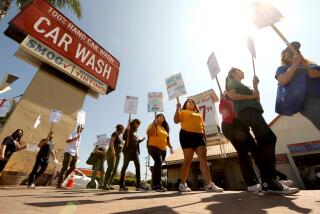No easy fix for California’s teacher pension crisis
- Share via
WEST SACRAMENTO — When the glass-sheathed headquarters of the California teachers’ pension fund opened five years ago, it was supposed to help anchor developments along the blighted riverfront on the capital’s outskirts.
But as Jack Ehnes, the fund’s chief executive, looked out from a top-floor conference room on a recent afternoon, he could see patches of empty land where nothing had been built.
Construction plans, he said, took a huge blow from the recession.
The same could be said of the California State Teachers’ Retirement System, or CalSTRS, which Ehnes has run for more than a decade. Today, the pension fund is one of the biggest financial problems in a state with more than its share of money woes.
Gov. Jerry Brown and legislative leaders are pledging to repair and replenish the $181.1-billion retirement system that is supposed to finance more than 800,000 retirements for public school teachers, administrators and community college instructors. Hearings on possible solutions began in the Capitol on Wednesday.
The second-largest public pension fund in the country, after California’s primary pension system for public employees, it faces a $71-billion shortfall that worsens by $22 million every day, according to pension officials.
Ehnes said stock market gains won’t fix things, that more money must come from the state, school districts, school employees, or all three.
Without corrective action, he said, “this plan will be insolvent in 30 years,” when a young teacher hired today would probably retire. At that point, the full cost of teachers’ pensions would fall squarely on taxpayers’ shoulders, raising the specter of tax hikes or cuts in government services to compensate.
The Legislature and governor must approve any increases in contribution rates, but negotiations will be fraught with political peril, especially in an election year.
Pension officials fault the recent recession for much of the shortfall, but lawmakers and governors — many of whom benefited from teachers’ union campaign contributions — took actions over the years that helped set the stage for today’s problems.
In particular, when the pension fund was bursting with money 15 years ago, they boosted teachers’ pension benefits while simultaneously reducing the state’s contributions.
David Crane, who was appointed to the fund’s board by Republican Gov. Arnold Schwarzenegger in 2006 but never confirmed by Democratic lawmakers, blamed the state’s leaders.
“These problems at CalSTRS are caused entirely by politicians making promises and not setting aside money to meet those promises,” Crane said.
Teachers do not receive Social Security, and the average retiree last year left his or her job at age 62 with a monthly pension of $3,980 after working 25 years. In the fiscal year that ended in June, payments into the pension fund were far short of what’s needed to keep the system healthy, according to state reports.
School employees, school districts and the state put in $6 billion; the fund needed $4.5 billion on top of that and will require more if investment returns don’t meet expectations.
That’s a steep fall from 1998, when the teacher retirement system was fully funded for the first time in its history. The state’s contributions had been hiked in 1990, and California was riding high on its roaring dot-com industry. The stock market was booming.
The Legislature began enriching retirement benefits for teachers, whose pension calculations are not as generous as those of many other public employees. The California Teachers Assn., one of the state’s biggest campaign donors, had recently flexed its political muscle, spending $1.3 million helping Gray Davis, a Democrat, be elected governor in 1998.
Some of the most generous proposals were approved in 2000. Teachers who worked at least 25 years could count on bigger retirement checks because their pensions would be calculated on their highest single year of salary, rather than on an average of the top three.
They would also receive longevity bonuses if they crossed the 30-year employment threshold over the following 10 years.
Those measures, which received bipartisan support, were viewed as a key way to boost teacher recruitment and retention.
“We didn’t have as many new teachers coming into the fold, and we had a lot of older teachers getting ready to retire,” said John Hein, then a CTA lobbyist.
Lawmakers also created a new, supplemental retirement account for teachers that lasted 10 years. To fund it, they diverted some contributions from the main account — without reducing payouts from it — for 10 years.
A bare-bones legislative analysis said stock market gains would “absorb the cost” of the change.
Rep. Tom McClintock (R-Elk Grove), an assemblyman when the bill was approved, voted against the change, which he called “cheap political gain at enormous long-term expense.”
“It was an easy vote to promise benefits without having to pay for them,” he said.
Lawmakers also reduced what the state paid into the main pension fund. The contribution dropped from 2.6% of the statewide teacher payroll in the 2000-01 fiscal year to 2% in 2003-04.
Teachers continued to pay in 8% of their salaries, as they have since 1972. Schools have contributed 8.25% of their payrolls since 1990.
Soon after benefits were expanded, the dot-com bubble deflated in 2001, sapping the pension fund’s earnings. Within a few years, the shortfall was $20 billion.
At that point, Ehnes said, there was a 40% possibility that returns on investments, rather than more contributions, would fix things. Lawmakers took those odds.
But the market crashed in 2008, and the pension fund lost a quarter of its assets in one year, dropping to what is considered an unhealthy level of funding.
State Supt. of Public Instruction Tom Torlakson, who voted for expanded benefits as a Democratic assemblyman, said there was no reason to anticipate such a catastrophe.
“Crystal balls work some of the time, but not most of the time,” he said. “We didn’t predict the incredible stock market crash and the real estate crunch.”
In January, when Brown unveiled his latest budget proposal, he said there would be “disaster ahead” if the pension shortfall is not addressed. But the governor, who has benefited from union support and faces reelection this year, says in the spending blueprint that he’s willing to wait until next year to put a plan in place.
He wants to repay debts incurred during past budget crises and supports a proposal to stockpile cash to protect the state against future economic turbulence.
Assembly Speaker John A. Pérez (D-Los Angeles), who is running for state controller, said the state must begin making changes this year: “Further delays only mean further costs.”
A tax surplus is expected this year, but Democratic lawmakers have a long spending list, and several of their proposals could be popular with voters. They want more money devoted to preschool programs, social services and healthcare for the poor, for example.
Schools, for their part, are wary of paying more for pensions after suffering budget cuts during the recession.
“There is some concern about having an additional bill being laid on us,” said Megan Reilly, chief financial officer at the Los Angeles Unified School District.
Lobbyist Jennifer Baker said the teachers union is willing to have members pay more for their pensions, but the state is required to provide them with an equivalent benefit. She said that could be as simple as guaranteeing cost-of-living increases for pension payments, which the state now provides voluntarily.
A guarantee would boost retirement security for teachers without raising costs, Baker said.
Dave Elder, a Democratic assemblyman from the Los Angeles area who successfully pushed to raise state funding for pensions in 1990, said the best idea is to do again what he did then: slowly ramp up the state’s payments.
“It’s not brain surgery,” he said.
More to Read
Sign up for Essential California
The most important California stories and recommendations in your inbox every morning.
You may occasionally receive promotional content from the Los Angeles Times.











